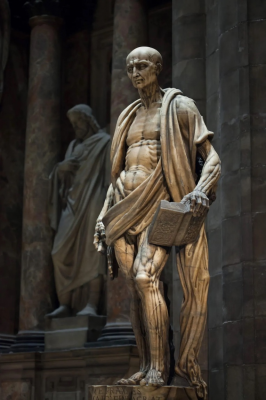Gospel in Art: Saint Bartholomew Flayed

Sculpted by Marco d'Agrate, 1562 © Duomo di Milano
Source: Christian Art
24 August 2022
Feast of Saint Bartholomew
John 1:45-51
Philip found Nathanael and said to him, We have found the one Moses wrote about in the Law, the one about whom the prophets wrote: he is Jesus son of Joseph, from Nazareth' ''From Nazareth?' said Nathanael. 'Can anything good come from that place?' 'Come and see' replied Philip. When Jesus saw Nathanael coming he said of him, 'There is an Israelite who deserves the name, incapable of deceit.' 'How do you know me?' said Nathanael. 'Before Philip came to call you ' said Jesus 'I saw you under the fig tree. You will see greater things than that. And then he added, 'I tell you most solemnly, you will see heaven laid open and, above the Son of man, the angels of God ascending and descending.'
Reflection on the sculpture
Today we celebrate the Feast of Saint Bartholomew, one of the twelve apostles. He travelled extensively to spread the Word of God, and visited places such as India, Ethiopia, Lycaonia (modern Turkey), Parthia (modern Iran) and Armenia. It is there in Armenia that the apostle is said to have been martyred by flaying and beheading at teh command of the Armenian King Astyages.
Our sculpture today, in the Duomo of Milan, shows the saint having been flayed of his skin. Mad by sculptor Marco d'Agrate in 1562, we see St Bartholomew carrying what looks like a cloak around his shoulders and around his body. But it is his own skin. The sculpture shows little emotion or pain. It is more a study and presentation of human anatomy, typical of the 16th century interest in science and the body. The sculpture is therefore as much an exercise in virtuous academic study of the muscles and structure of the human body as it is of Saint Bartholomew.
The sculpture is highly classical in style - so much so that the there is a short inscription at the foot saying: "Non me Praxiteles, sed Marcus finxit Agrates". (" not sculpted by Praxiteles but by Marco d'Agrate") referring to the artist's fear that the piece was so classical in style it could have been attributed to Praxiteles, one of the most skilled and famous sculptors from Athens in ancient Greece.
Saint Bartholomew was stripped of his skin, his ultimate sacrifice, in order to bear witness to God. He teaches us how in order to serve God , we ultimately might get stripped of everything too before meeting our Maker ...
LINKS
Christian Art: https://christian.art/
Today's image: https://christian.art/daily-gospel-reading/john-1-45-51-2022/


















